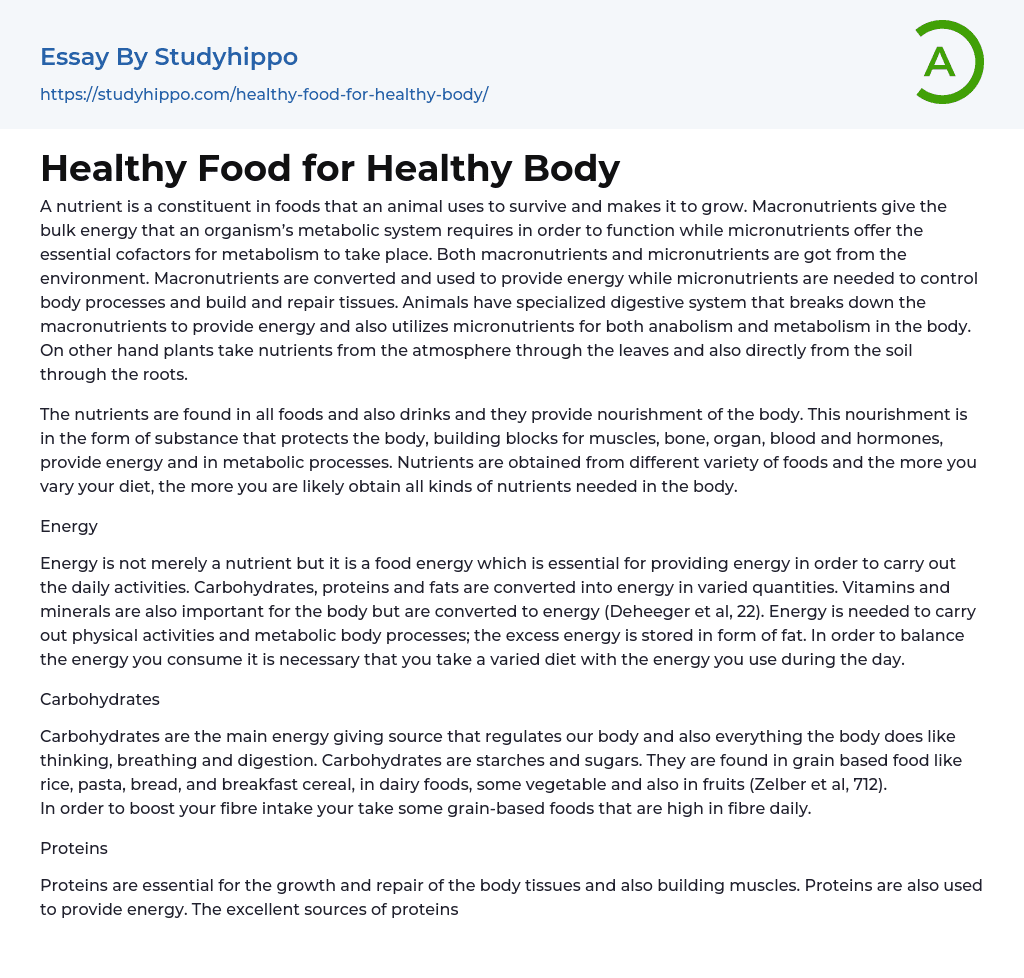Animals require nutrients present in food to sustain life and promote growth.
Macronutrients and micronutrients are both obtained from the environment and play important roles in an organism's metabolic system. Macronutrients provide essential energy for metabolism, while micronutrients support bodily processes, tissue growth, and repair. Animals have a specialized digestive system that breaks down macronutrients for energy and utilizes micronutrients for various functions within the body.
Plants obtain nutrients from the air through leaves and from the soil through roots, which are necessary for their growth. Similarly, these nutrients can be found in foods and drinks, nourishing our bodies. They have various functions such as serving as a protective substance and acting as building blocks for muscles, bones, organs, blood, and hormones. Additionally, they provide energy and support metabolic processes. Consuming a variety of foods is essentia
...l to ensure getting all essential nutrients.
Energy
The body requires energy for daily activities, which is considered both a nutrient and referred to as energy. Energy production is influenced by carbohydrates, proteins, and fats, each providing different amounts of energy. Additionally, vitamins and minerals play a critical role in the body's energy production (Deheeger et al, 22). Physical activities and metabolic processes rely heavily on energy, with any excess being stored as fat. To achieve a balance between energy intake and expenditure, it is essential to maintain a diverse diet that fulfills your daily energy requirements.
Carbohydrates and Proteins
Carbohydrates are the main source of energy for our body's activities, while proteins are essential for growth, repair of body tissues, and muscle development. Carbohydrates can be divided into starches and sugars and can be found in various foods such as rice, pasta, bread
breakfast cereal, dairy products, specific vegetables, and fruits (Zelber et al., 712). To increase fiber intake in your daily diet, it is recommended to include high-fiber grain-based foods.
Proteins, which serve as an energy source, can be obtained from various sources. Animal-based foods like meat, fish, eggs, chicken, yoghurt, cheese, and milk are excellent protein sources. Vegetables such as legumes (e.g., baked beans, soybeans, chickpeas, lentils, and kidney beans), seeds, and nuts also contain ample protein (Zelber et al., 715). Additionally, grain-based foods like cereals, pasta, bread and rice contribute to one's protein intake.
When choosing foods, it is crucial to opt for those that are high in proteins and low in saturated fats. Fats play a role in providing energy and aiding in the absorption of vitamins; therefore, a well-balanced diet should incorporate some amount of fat. Animal sources are the primary origins of saturated fats, while vegetables predominantly supply unsaturated fats (Deheeger et al, 24). It is advised not to surpass the recommended intake due to the high-energy content present in fats. To consume unsaturated fats, it is essential to include items such as seeds and nuts, oily fish, avocado, olive oil, rapeseed oil, and spreads made from sunflower oil.
Sodium (Salt)
Excessive salt consumption can lead to various health problems as it increases blood pressure. Many diets have high sodium levels due to the use of salt in packaged foods. To maintain a healthy heart, it is important to limit sodium intake (Zelber et al, 717).
Sugars
Sugars are carbohydrates that provide energy for the body. They naturally occur in dairy products, fruits, and vegetables and are also
added to food for purposes like enhancing texture, color, and flavor (Deheeger et al, 25).
A deficiency, also known as dietary deficiency, occurs when the body does not have enough of a particular nutrient due to factors like insufficient intake, destruction, excretion, or absorption. On the other hand, nutrient toxicity refers to the exposure of an organism to excessive nutrients without harm. Nutritional diseases encompass ailments caused by both excessive and insufficient dietary intake, eating disorders, obesity, chronic diseases such as hypertension, diabetes mellitus, cancer, and cardiovascular disease. These diseases may also include developmental abnormalities that can be prevented through hereditary conditions responding to dietary treatment diet intolerances and food allergies ,the interaction between nutrients and drugs,and potential risks in the food supply (Zelber-Sagi et al.). The article titled "Long term nutritional intake and the risk for non-alcoholic fatty liver disease (NAFLD): a population-based study" was published in the Journal of hepatology 47.5 (2007), pages 711-717.
M. Fontvieille conducted a study on 10-year-old French children to explore the relationship between physical activity, body composition, and nutritional intake. The findings of the study were published in the "International Journal of Obesity & Related Metabolic Disorders" in 1997.
- Poison essays
- Action Potential essays
- Nervous System essays
- Childbirth essays
- Puberty essays
- Blood essays
- Kidney essays
- Neuron essays
- Body essays
- Glucose essays
- Sense essays
- Heart essays
- Skeleton essays
- Human Physiology essays
- Eye essays
- Immune System essays
- Muscle essays
- Skin essays
- Brain essays
- Central Nervous System essays
- Human Skin Color essays
- Digestive System essays
- Common sense essays
- Respiration essays
- Food essays
- Genetically Modified Organisms essays
- Child Development essays
- Eating essays
- Breakfast essays
- Genetically Modified Food essays
- Milk essays
- Chewing gum essays
- Energy Drink essays
- Caffeine essays
- Chocolate essays
- vegetarian essays
- Weight Loss essays
- Anorexia essays
- Metabolism essays
- Diet essays
- Vitamin essays
- Dieting essays
- Junk Food essays
- Eating Habits essays
- Food Safety essays
- Food Security essays
- Beverages essays
- Cuisines essays
- Dairy essays
- Desserts essays




